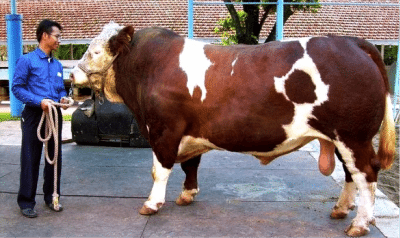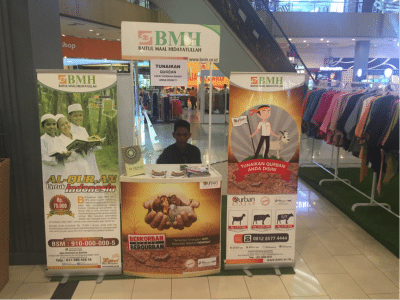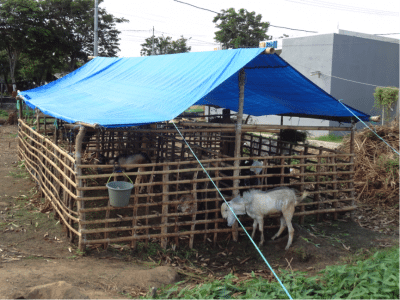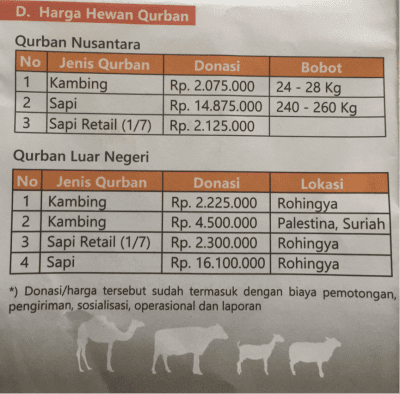The Indonesian festival of Qurban was celebrated on the 12th of September this year. This is not only a very important religious festival but also has an enormous impact on the domestic supply of cattle, sheep and goats.
Official figures from the Government of Indonesia record that during the previous annual Qurban, slaughter numbers for this single day festival were in the order of 300,000 head of cattle and about 1 million head of sheep and goats.
“Eid al-Adha, (Festival of the Sacrifice), also called the “Sacrifice Feast”, is the second of two Muslim holidays celebrated worldwide each year, and considered the holier of the two.
It honors the willingness of Abraham to sacrifice his son, as an act of submission to God’s command, before God then intervened sending his angel Gabriel to inform him that his sacrifice had already been accepted.
The meat from the sacrificed animal is divided into three parts. The family retains one third of the share; another third is given to relatives, friends and neighbours; and the remaining third is given to the poor and needy.”
I have copied this description directly from an internet site in the hope of getting the wording correct, as I am certainly not knowledgeable in these religious matters.

Some people go to great lengths to donate magnificent animals for sacrifice and meat distribution to the poor.
What may not be immediately obvious to non-Muslim observers is that this festival has a very strong element of charitable donation.
Those Muslims who can afford it, effectively purchase and donate animals to their mosque which sacrifices them according to Islamic principles with the meat distributed to the poor.
This is a highly organised process in Indonesia, especially in the larger cities where some people may not have the capacity to physically go out and buy their own animals and arrange the slaughter process with their local mosque, although most still do.
The photo below shows one service provider (in a Jakarta shopping mall) offering the full service to those wishing to donate, including the capacity to complete the entire process on-line.
This is a very sophisticated system which not only allows Muslims to donate to their own local population but also to poor Muslims in other parts of the world. In the case of this organisation, they facilitate the purchase of livestock both locally and in Palestine, Syria and for the Rohingya’s (who I assume are in Myanmar).

During the lead up to Qurban, booths like this one pop up in shopping malls and public areas all over Indonesia making it easy for Muslims to donate animals to the poor.
See below the pricing options for Qurban Nusantara (Indonesia) and Qurban Luar Negeri (overseas). The prices for cattle are about AUD$6 per kg for a 250 kg bull while sheep and goats cost about $8 per kg. The price for overseas donations is a little higher. The exchange rate is roughly 10,000 Rupiah to $1 AUD.
There are lots of rules associated with the process but essentially only cattle, sheep, goats and camels are eligible for sacrifice.
They are usually male and should be free of blemishes and treated humanely prior to and during the slaughter process. In the case of people wanting to buy a bull but not being able to afford the higher price, there is a formula which allows 7 people to get together and collectively purchase one bull. This 7 to 1 ratio relates to the meat from 7 sheep or goats being roughly equivalent to one bull. While the official sharing of the meat is in three parts, it is very common for the donor to allocate all the meat to the poor.
Although Qurban is a religious festival, it clearly has a massive impact on the commercial livestock industry in Indonesia (and elsewhere). As the largely Muslim population of Indonesia becomes more prosperous, (annual GDP growth just under 5%) they tend to donate greater amounts to charity.
Nobody knows the exact population of cattle in Indonesia but most estimates range from 6 to 12 million head.
I will use a total of 9 million for this “back of the envelope” calculation where, of this 9 million, 3.5 million might be mature breeding females.
An 80% calving rate will deliver 2.8 million calves of which 1.4 million will be males. These calves need to grow to about 2 years old to be eligible for sacrifice so with a young stock death rate of say 7% per annum this leaves about 1.2 million head of 2 year old males each year suitable for Qurban.
About 300,000 or 25% of these are killed on this one day of the year. I don’t have any similar figures for the festivals of Ramadan and Lebaran but they might easily consume twice this number considering that these festivals are spread over about 5 weeks.
The bottom line of this crude estimate suggests that for the other 10.5 months of the year there might only be about 300,000 males available for slaughter across the entire country placing huge pressure on the slaughter of cows even though slaughter of productive females is against the law.
These numbers would suggest that the cattle herd is under such great slaughter pressure that it may actually be shrinking in size at the same time as demand for suitable animals for religious festivals and normal consumption continues to rise.
Live cattle imported from Australia are not suitable for slaughter for Qurban for a number of reasons, so all Qurban cattle must be sourced from the domestic herd.
The local sheep and goat populations are not under the same pressure as a shorter gestation period and their capacity to produce a high proportion of twins allows their numbers to recover each year.

As Qurban approaches, temporary sale yards like this one appear on strategically located vacant land all over Indonesia so prospective donors might personally select their animals.

